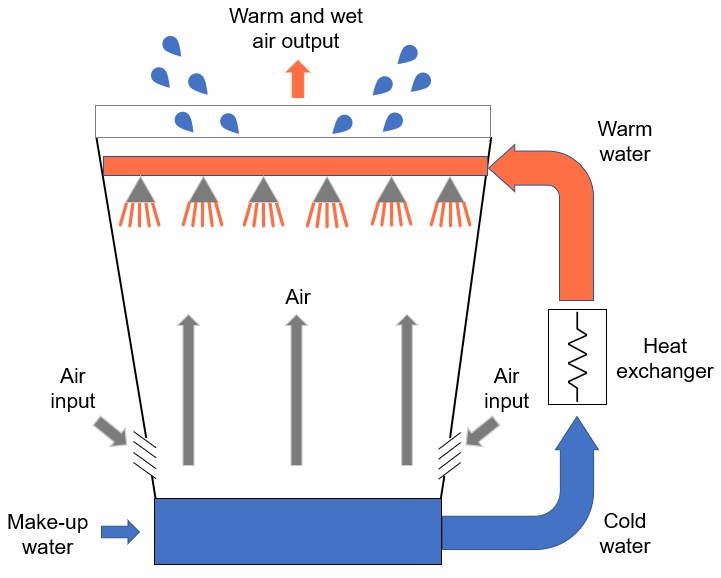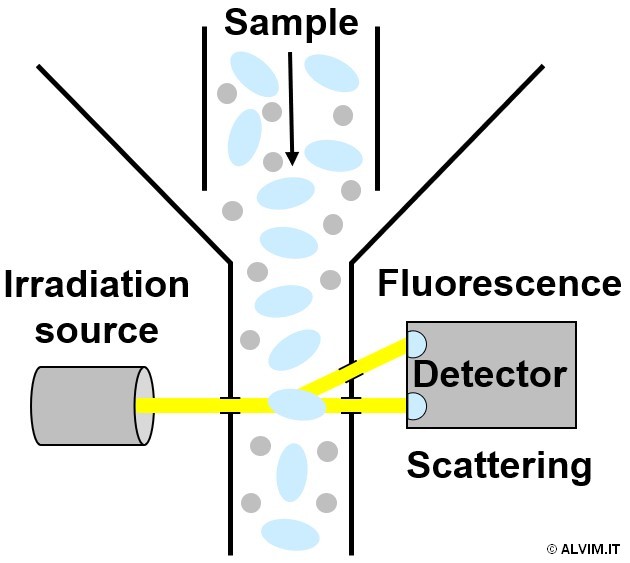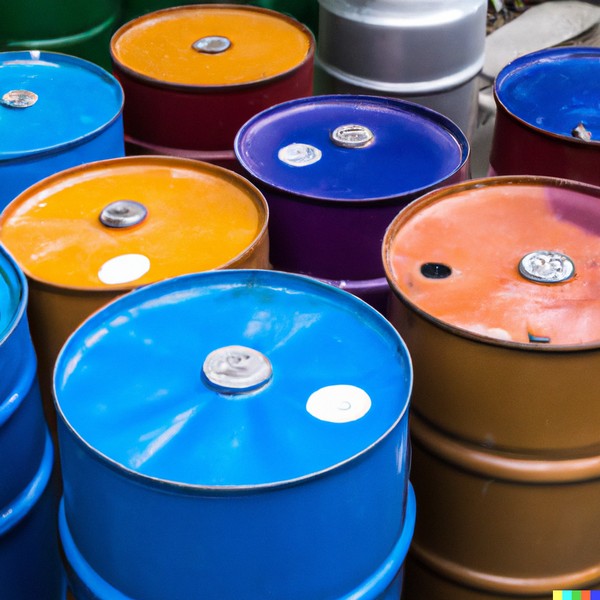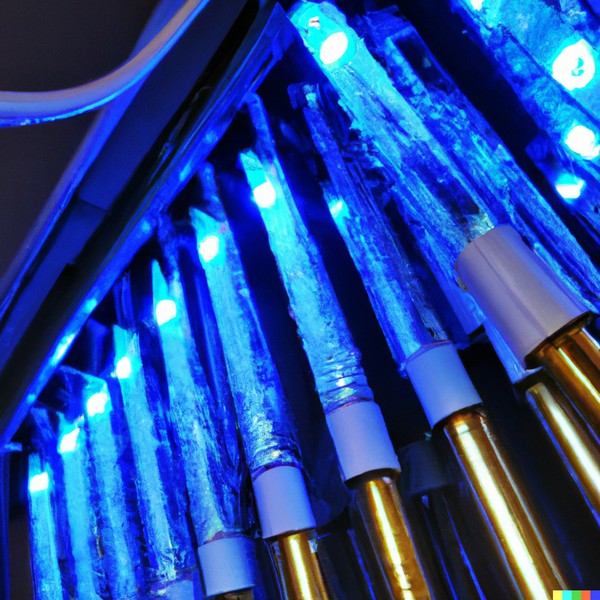Cooling towers [Download this white paper as PDF file]
Cooling towers (CTs) have always been considered the most reliable, consolidated and efficient heat dissipation systems available on the market. They are very simple machines that are used for cooling water in industrial processes. Cooling towers are also part of the heating, ventilation, and air conditioning systems (HVAC) in buildings. Their purpose is to cool and hold water that is used to dissipate heat from heat exchangers. Cold water from CT is pumped out to absorb heat from heat exchangers then, as warm water, it enters the top of the cooling tower to be cooled through evaporative cooling (see figure on the right). Warm water is sprayed from the top of the tower onto a surface, such as splash bars. Atmospheric air interacts with the water and a fan blows air up and out of the tower to increase cooling. Evaporative cooling releases heat from the system and produces an aerosol that is released into the environment through openings in the tower.

Cooling towers have only one moving part, the electric fan, and the water to cool is in direct contact with the air. Evaporation is the natural process that uses sensible heat and latent heat as a means of disposing of the thermal load. The process allow water to be cooled to a temperature lower than the air in the same environment, exploiting the latent heat of evaporation and the part of water that evaporates in direct contact with air. The amount of heat that is removed by evaporation is an important quantity, about 550-600 kcal for each kg of evaporated water. Therefore, a CT is a machine that allows water to be cooled efficiently with a low energy cost. On the other hand, evaporated water shall be refilled. The principle of evaporative cooling has been applied in the industry for decades, and the technology has constantly evolved. The role of CTs is extremely important, therefore, given their size and function, it is necessary to monitor them constantly, to avoid demanding interventions that require plant shutdown - and this is valid in particular for critical infrastructures, like nuclear power plants.
Bacteria-related issues in cooling towers
Although the CT process is effective in removing heat, it also causes serious sanitation and contamination concerns. Indeed, pathogenic bacteria that survive and proliferate in this environment can easily spread with aerosol, even for kilometers. Moreover, the microbiological layer ("biofilm") that quickly covers any surface in contact with water may cause microbially induced corrosion (MIC) or biocorrosion, which can reduce the performance, increase the energy consumption and decrease heat exchange, resulting in lower efficiency.

Several studies have reported that, just in the USA, 4% of the failures of power stations are caused by general fouling - including biofilm, organic and inorganic particles. Many studies carried out also in Europe and in other regions showed that exchanger fouling leads to increased maintenance costs. The most relevant organisms that impact cooling towers are typically algae and bacteria. They can live free in the water (planktonic form) or settled on surfaces (sessile form), with the latter representing the largest part, usually known as biofilm. This is a community of microorganisms, established on a surface, surrounded by an extracellular matrix made up of polysaccharide polymers (EPS), DNA and proteins. In this micro-ecosystem, the conditions are ideal for microbiological growth - this is why it is much more efficient to be sessile than hunt for food. The large surface area, low water flow velocity, and warm temperature that can be found in CTs greatly contribute to the formation of this biological layer. The evaporative cooling process increases the concentration of organic and inorganic materials in water, supplying large amounts of food to bacteria. Additionally, construction materials of CTs may provide a good substrate for bacterial settlement and proliferation. Moreover, leaching of biodegradable compounds can result in higher biomasses of biofilm. The formation of this biological layer poses many threats to cooling towers, first of all its ability to act as a reservoir of pathogens. EPS protect bacteria from environmental conditions, antibiotics, and sanitation treatments. For this reason, biofilm is able to resist sanitation treatments that easily kill planktonic cells. As a result, pathogenic bacteria can persist and multiply in this environment. When they are released, because of water flow, chemical treatments or other factors, they contaminate the water and thus the environment, travelling with the water droplets released by the tower. Some known pathogens of concern in cooling towers are Legionella pneumophila and Pseudomonas aeruginosa. L. pneumophila causes Legionnaires Disease, through inhalation of cooling tower aerosol containing these bacteria, as discussed more in details in a specific white paper. Biofilm protects L. pneumophila from sanitation treatments and allows it to survive in conditions that are not ideal for the pathogen. Moreover, it can increase its antibiotic resistance. For all these reasons, to ensure an effective prevention, sanitation treatments shall be applied as soon as biofilm starts to form.
Monitoring microbial populations in CTs water is essential to minimize health risks for the population. The control of Legionella proliferation in cooling tower water circuits requires regular monitoring and effective disinfection procedures. Legionella-contaminated CTs can cause severe health problems and even lead to the death of infected individuals living in the proximity.
Microbiological monitoring methods
Many different options exist, for monitoring bacteria in the industry, as discussed in a previous paper. The following are those most commonly applied to CTs.
The main scopes of microbiological analyses, in cooling towers, are checking the effectiveness of biocides and preventing Legionella contamination. To this aim, water sampling and laboratory analysis is the most widely applied approach. Unfortunately, this method has some important drawbacks. First of all, this option can be expensive and time consuming - depending on the number of samples and on the specific analyses to be carried out. Secondly, only free-floating bacteria are detected - but these can be as few as 10% of the total, since up to 90% of microorganisms live attached to surfaces, in the biofilm. Last but not least, just 1% of the bacteria from an environmental sample can be detected by laboratory culturing techniques. For these reasons, this approach can greatly underestimate the real microbiological contamination.

To sample and study biofilm, coupons can be immersed in water, usually in a rack positioned in a bypass (see figure on the right). Then, coupons are periodically retrieved and analyzed, by means of different techniques.
For what concerns Legionella, health risk management is based on verifying that contamination level in water falls below alert threshold. With more than 103 colony forming units per liter (CFU/L), risk analyses and corrective actions shall be applied. With more than 105 CFU/L, emptying, cleaning and disinfection of the system is strongly suggested.
This approach has many drawbacks in terms of risk management. First of all, it is time consuming, since samples shall be sent to a laboratory, and their incubation usually takes 24-48 hours.
Furthermore, as mentioned above, less than 1% of bacteria found in the environment grow in culture media. An important part of the microbial population, usually known as viable but non-culturable (VBNC), has not or has lost its ability to form colonies on agar plates under stress conditions. However, these bacteria may still be active, and even pathogenic.

ATP measurement is often used in the field, and it provides an insight into total microbial activity. Even if it is not specific, it appears as a quick and easy way to estimate the overall activity of a microbial population in a sample, either liquid or taken from a surface (e.g. swab or coupon). Quantitative data via ATP measurement are obtained indirectly, i.e. the calculated amount of cells is proportional to the measured fluorescence intensity. This principle is generalized for all types of microorganisms, even if this may lead to a large inaccuracy.
Flow cytometry (see figure on the right) is an alternative technique that allows for the qualitative and quantitative characterization of cells suspended in a liquid. In addition to rapid quantification, flow cytometry can provide information on the physiological state of cells (total vs. viable). This technique allows for a direct determination, which is not possible with ATP measurements and other techniques. However, it is hard to apply in real conditions, and it detects just free-floating bacteria, not biofilm.
In this context, ALVIM Biofilm Sensor represents an outstanding solution to monitor bacterial growth in cooling towers, on line and in real time. Reducing the time and cost to carry out this activity, it allows for a general improvement of the process.
Sanitation methods
To control microbiological proliferation in CTs, chemical and physical treatments can be applied, separately or together. Whatever the method, it should be fast, cost-effective and reliable over a wide range of pH and temperatures. The most commonly adopted approach is the dosage of biocides, such as chlorine or ozone, as discussed more in depth in a specific white paper. Biocides are dosed intermittently or almost continuously for the control of bacteria, biofilm, fungi, algae and protozoa. This is also the most widely used method for controlling Legionella in cooling towers.

Chlorine is one of the most popular oxidizing biocides used in CTs. One of the major benefits of chlorination is that it is effective in inactivating a wide range of microorganisms. On the other hand, it leads to the formation of harmful disinfection by-products (DBP) and it increases corrosion rates. High temperatures or pH, common conditions for cooling towers, reduces chlorination efficacy.
Chlorine dioxide is more effective than chlorine, even at lower concentrations. Chlorine dioxide has been extensively used as a disinfectant in many applications, from drinking water treatment to industrial wastewater. The formation of DBP is lower with chlorine dioxide, due to its lower reactivity with organic matter. Last but not least, this biocide is effective over a wide pH range.
Ozone is one of the oxidizing biocides most widely used in water treatment, since it shows an efficacy higher than chlorine, even at low concentration. A dosage between 0.2 and 0.5 mg/L was proved to control biofouling to an acceptable level, even in applications with a high biological load. Due to its rapid decomposition, it is often coupled with other disinfectants.
Isothiazolinone is used for microbial control in a number of industrial water treatments. Laboratory and field studies have shown excellent biofouling control against algae in CTs. Isothiazolones are compatible with construction materials, ion exchange media and ultrafiltration membranes. They are degraded by reducing agents and high pH (>9). They generally degrade rapidly in aquatic environments to non-toxic by-products.

Copper-silver ionization is an alternative method of sanitation, that induces the controlled dissolution of silver and copper electrodes. The release of such ions into the water kills bacteria. Unfortunately, an elevated pH can inactivate this method. Even in the best conditions, this option is considered less effective than most chemical biocides.
Among physical methods, UV irradiation is one of the most widely applied techniques in water treatment. It is generally used to sterilize clean water, such as drinking water and distilled water, where it is effective and rather fast. It can be applied also to cooling water even if, in this kind of application, UV is generally less effective than biocides. This is mainly due to the insufficient penetration of the light in turbid water. Studies showed that, in some conditions, this method was not able to prevent the propagation of Legionella, nor to prevent biofilm formation on the internal surfaces of the cooling tower. Another physical treatment that received some attention is electronic pulse generation. This method is based on high voltage pulsed electric fields sent through the water, to create pores in the cell membrane, resulting in cell lysis. Multiple high-intensity pulses proved to be capable of causing more irreversible damage than single-shot electrical pulses.
Conclusions
The control of bacterial proliferation in cooling towers is of outermost importance, both for public safety and for the functionality of the system. Bacterial growth, in particular biofilm, shall be limited as much as possible, starting from its very first phases.
Monitoring bacterial growth on surfaces in real-time, ALVIM Sensors allow to prevent biofilm-related issues, including Legionella contamination and microbiological induced corrosion. At the same time, this Technology makes possible to verify the efficacy of sanitation treatments. The ALVIM Biofilm Monitoring System is used in more than 30 Countries, all around the world. Application cases are available both for open cooling towers and for closed-loop cooling towers.
|
Do you have biofilm-related issues?
|





